Zoning to Control Future Growth
Citizens who shared the vision of the new city were uniformly concerned about mixed land use and high residential density. These were problems beyond the scope of building codes and good intentions (figs. 8.9, 8.10). Over the heads of all urban land investors hung the vultures of uncertainty and unpredictability, or as one developer put it, the problem of "premature and avoidable de-
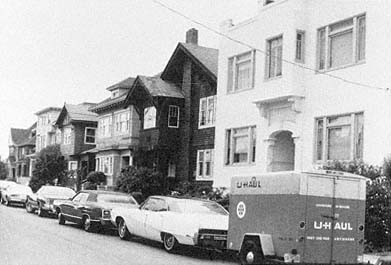
Figure 8.9
Street view of middle-income two-family and four-family houses on
Avon Street in Oakland, California, constructed between 1910 and 1925.
The light-colored Avon Hotel, at rear , appears to be another house.
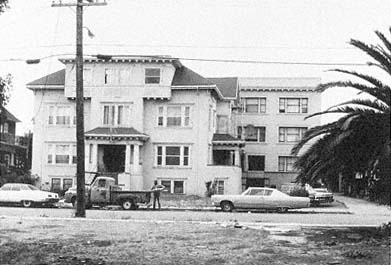
Figure 8.10
The Avon Hotel as it appears in the middle of the residential block.
Most zoning codes outlawed reproducing experiments like these.
preciation."[35] Moreover, one owner's adherence to codes had no automatic effect on buildings next door. If neighboring properties were sharply incompatible, spewing out noxious fumes, or crowded with the urban poor, then the value and potential use of even the best new building was sharply diminished.
The real estate industry in San Francisco, like its counterparts in other cities, first encouraged the use of restrictive covenants at the edge of the city to exclude nuisance uses, to prohibit subdivision of houses, and to disallow selling or renting to blacks, Asians, or Jews. The largest
use of restrictive covenants in San Francisco came in the new elite sub-divisions opened on the city's western side. But developers still worried that construction on the adjacent tracts could spoil their property values.
Closer to downtown, in the Western Addition, real estate promoters had the opposite problem. They wanted to ensure that the district would reach a higher density and do so with uniform heights and uses. Some Western Addition owners were building ten-story apartment towers on prime lots, but their structures stood next to old two-story Victorian houses or light housekeeping rooms (fig. 8.11).[36] Expert reformers taught that widespread land-use zoning, not covenants, would be the logical solution to keep such "old conditions in the larger cities" from "reproducing themselves" in outlying districts. Paul Scharrenberg, one of the five CIH commissioners, promoted zoning in San Francisco as a means to guide "right city growth." Veiller, too, called for zoning specifically "to keep apartment houses and hotels out of the private-residence districts."[37]
Whether one was using restrictive covenants or zoning, controlling land-use mixture and density carried negative implications for hotels. Banning retail activity from a housing neighborhood attacked one of the vital notions of hotel life—the home that was scattered up and down the street, with one's bedroom in one structure, the dining room at the local café, and so forth. Banning multiunit buildings next to lower-density structures struck at the notion of ad hoc rooming houses. As local and national zoning precedents were set, these implications for California hotels came more sharply into view.
San Francisco's zoning act, passed in 1921 and slightly modified in 1927, had typical antihotel provisions. For most unbuilt areas within the city limits, the act established "first residential districts" featuring the new city ideals of separate, single-family houses. Only religious, professional, and bucolic uses could be mixed with the residences; commercial mixtures were banned (fig. 8.12). Musicians, doctors, and dentists could work out of their home but not plumbers or auto mechanics. Nurseries, farms, truck gardens, and greenhouses were allowed but not corner grocery stores or bars. Zoning thus made uniform land use and desired densities as enforceable as the requirements for interior plumbing.
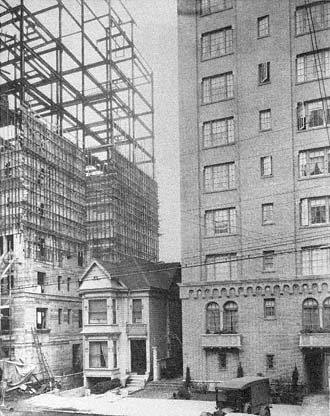
Figure 8.11
Nonuniform development in the northern reaches of
San Francisco's Western Addition, 1927. Investors saw a
surviving Victorian-era house like this, probably a rooming
house, as a threat to the property value of the tall buildings.
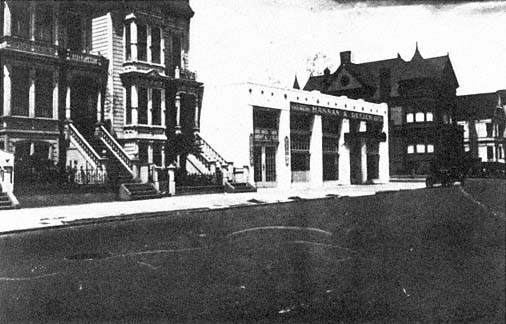
Figure 8.12
The "intrusion" of an auto dealership into a residence district. Illustration of negative land-use
mixture from a 1920 article promoting zoning.
Hotels were allowed in three of the other zoning categories. Mapped as "second residential areas" were the city additions built from 1880 to 1921. In such areas, the zoning ordinance allowed apartments, hotels, and six specified neighborhood institutions (libraries, for instance); however, new stores would not be allowed. Existing streetcar corridors with their lines of shops were in the commercial category, and hotels were allowed there. After a series of political appeals, hotels were also allowed in heavy industrial districts.[38]
With so many areas of San Francisco open to hotels in 1921, the effects of zoning may not seem significant. Indeed, the antihotel ideas within zoning ordinances did not initially affect hotel life significantly; yet they reshaped a debate that had dramatic effects several decades later. On the one hand, zoning gave city officials centralized power over the form of future locations for hotel life. On the other hand, zoning drew a very effective cordon sanitaire around the old city as it had been built by about World War I, to keep old city ideas from contaminating the new city. In these respects, zoning came to be powerful in several ways.
First, the inflexible administration of zoning cut off suburban hotel experiments such as the hotels built over corner groceries or corner bars in new additions to the city. Zoning laws and opinions could have been written to keep only the worst aspects of mixed use and mixed building types out of urban expansion. Bulk, occupancy, or lot-coverage guidelines written as performance criteria rather than as absolute proscriptions might have allowed hotel managers to continue experimenting with expensive one- or two-story hotels whose form, image, and clientele would have blended even with new automobile suburbs. Ample precedents for such congenial mixtures could be found in country clubs that coexisted with the most exclusive suburbs.[39] Had suburban developers actively fought for such variety in early applications of zoning, they probably would have won over the experts' objections.
Second, zoning retarded the establishment of new rooming houses even in those extensive older areas of San Francisco designated as second residential districts. New hotels were entirely legal in these areas, but zoning forbade other new commercial uses. Hence, the critically important tenant services and cash flow from first-floor business were
unhinged from the rooming house business above, sharply reducing profits.[40]
Third, the long strips of commercially zoned blocks on either side of streetcar and new automobile through-routes proved to be inhospitable to new hotel life. The older streetcar strips and nodes already had a mixture of hotels and rooming houses. At the newer edges of the city, hotel residents found incomplete commercial services, a narrow range of prices, or too little variety: eating at the same inexpensive restaurant every day did not support convivial hotel life. Farther out, in nascent automobile strips, pedestrian life was unpleasant.
A fourth effect was a consequence of eliminating rooming houses in suburbs. Rooming houses had allowed women to make a living within one of their traditional roles, keeping house.[41] Zoning in effect eliminated expansion of these women's businesses.
Fifth, a succession of court decisions supported the elite and professional opinion that hotels should be excluded not only from the growing edges of the city but also from the entire city. It did not matter that hotels were popular or necessary or chosen as homes by a fraction of the downtown public.
The early court cases testing zoning show the degree to which hotels and rooming houses were on the minds of urban land-use experts. Initial state supreme court reviews disagreed about such basics as any land-use exclusions and zoning's uses of the police power; thus, excluding hotels, flats, and apartments from areas of single-family houses was logically more difficult for the courts. Miller v. Los Angeles , an influential case heard in 1925 before the California Supreme Court, summarized several earlier antihotel court opinions. The judges upheld the exclusion of a four-flat building from an area of single-family houses, and their opinion ranged widely to discuss apartments and hotels as well as flats.[42] They admitted that "undoubtedly, many families do maintain ideal home life in apartments, flats, and hotels" and that "in many single family dwellings there is much of dissention and discord." Nonetheless, the court also assumed that life in apartments and hotels was never chosen:
Few persons, if given their choice, would, we think, deliberately prefer to establish their homes and rear their children in an apartment house neighborhood
rather than in a single home neighborhood. . . . It is needless to further analyze and enumerate all of the factors which make a single family home more desirable for the promotion and perpetuation of family life than an apartment, hotel, or flat.[43]
This ruling influenced other courts. The Minnesota Supreme Court in 1925 rationalized exclusion of multiple-family structures as a reasonable reaction to urban population pressures.[44] A judge in Cleveland, Ohio, bluntly repeated the opinion that apartment buildings not only spread infectious diseases but also promoted immorality.[45] Many of the court opinions invoked expert academic scholarship—like that of the Chicago school of sociology—to reject apartments and hotels as valid housing. A law review article said "sound sociological arguments" led to the belief that open-lot houses were better than flats.[46] In fairly subtle ways, the decades of objections to hotel life by national figures such as Veiller, Woods, Abbott, and Park and California figures like Lubin and Porter had an important effect.
The gathering of antihotel opinion was particularly clear in 1926, when the Supreme Court of the United States handed down its decision on Euclid v. Ambler , the landmark zoning case concerning a Cleveland, Ohio, suburb and a small local realty company.[47] Writing for the court, the archconservative justice, George Sutherland, not only upheld the private house ideal but also helped to relegate all hotels and apartments into the category of hazards for the new city. Sutherland found no problem supporting the exclusion of industrial activity (as a nuisance) from residential areas; more difficult, he said, would be the "creation and maintenance of residential districts, from which business and trade of every sort, including hotels and apartment houses, are excluded." For this exclusion, the court could not rely solely on the concept of nuisance. Instead, said Sutherland, the court was convinced by "much attention at the hands of commissions and experts" that apartments and hotels, like steel mills, were a hazard to public health and safety when they were placed next to single-family houses (fig. 8.13). Within one year after Euclid v. Ambler , forty-five states had enacted enabling legislation for local zoning. Municipal and state courts were henceforth freed from the narrow confines of the common law of nuisance and police power that had constrained the limits of earlier building and health codes.
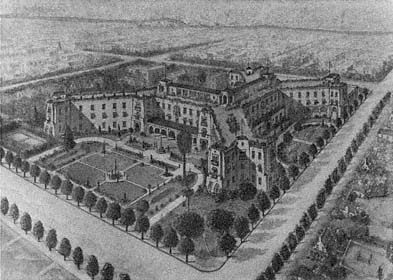
Figure 8.13
An apartment and tourist hotel in a residence district of the San Francisco
Bay Area suburb of Alameda. Opinions on the mixture of houses
and hotels varied widely: the city's Chamber of Commerce began this
hotel in 1926, the same year as the Euclid v. Ambler ruling. In the 1990s,
small bungalows and Victorian houses still abutted the hotel on two sides.
In 1932, President Herbert Hoover summed up the argument: "Zoning and city planning save waste, reduce ultimate costs, and add attractiveness and other social values to stable investment values for home owners."[48] For Hoover, investment stability was the ultimate social aim, just as it was for the majority of those who gained from the notion of an immutable new city. When reformers elevated the ideal of the privately owned American home as the single goal of national policy, the idea grew dramatically in power. This single-minded focus on the single-house concept would become in itself another strategy for eliminating hotels and apartments.